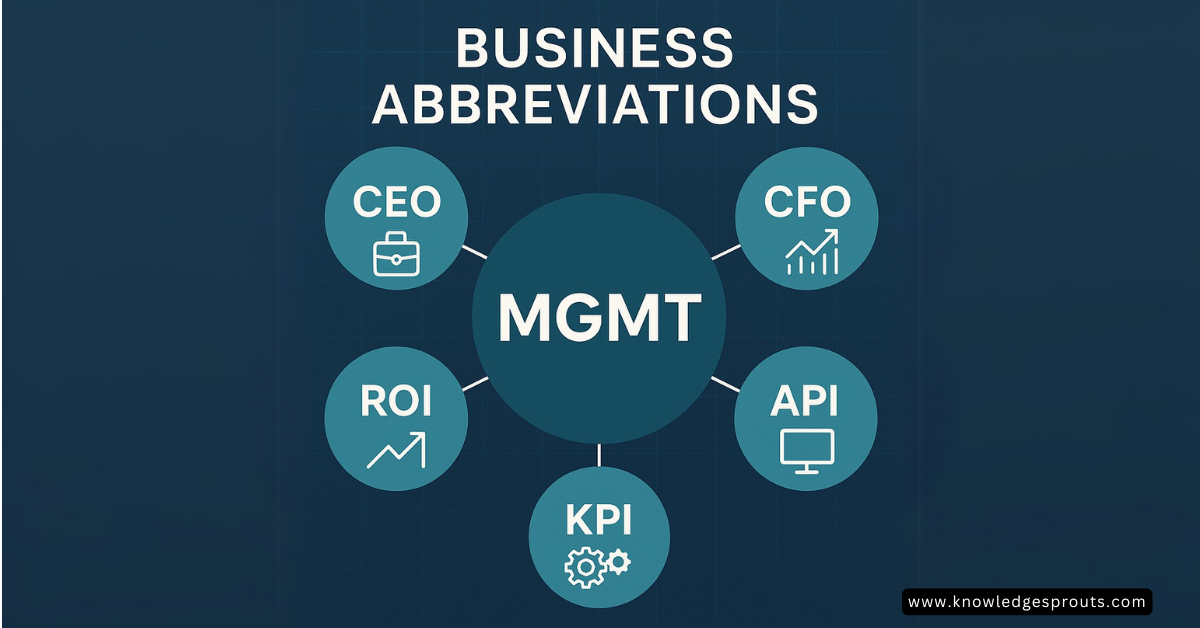Book Appointment Now

125 Management Abbreviations: Complete Business Guide
Master business communication with this comprehensive guide to management abbreviations. Save time, improve clarity, and navigate the corporate world with confidence. Let’s dive in.
- Executive & C-Suite Abbreviations
- Financial Management Abbreviations
- Operations & Project Management Abbreviations
- Human Resources & Legal
- Technology & Information Systems
- Marketing & Sales
- General Business & Administrative
- Time & Performance Metrics
- Why Management Abbreviations Matter
- Best Practices for Using Abbreviations
- Conclusion
Executive & C-Suite Abbreviations
Core Leadership Positions
CEO – Chief Executive Officer The highest-ranking executive responsible for overall company strategy and operations.
CFO – Chief Financial Officer Oversees financial planning, risk management, and financial reporting.
COO – Chief Operating Officer Manages daily operations and implements strategic initiatives.
CTO – Chief Technology Officer Leads technology strategy and innovation initiatives.
CMO – Chief Marketing Officer Directs marketing strategy and brand management.
CIO – Chief Information Officer Manages information systems and technology infrastructure.
CHRO – Chief Human Resources Officer Oversees HR strategy, talent management, and organizational development.
CLO – Chief Legal Officer Manages legal affairs and regulatory compliance.
CSO – Chief Security Officer / Chief Strategy Officer Handles security protocols or strategic planning (context-dependent).
CPO – Chief Product Officer / Chief People Officer / Chief Procurement Officer Varies by organization – can oversee products, people, or purchasing.
Emerging C-Suite Roles
CDO – Chief Data Officer / Chief Digital Officer Manages data strategy or digital transformation initiatives.
CRO – Chief Risk Officer / Chief Revenue Officer Oversees risk management or revenue generation strategies.
CISO – Chief Information Security Officer Focuses specifically on cybersecurity and data protection.
CAO – Chief Administrative Officer / Chief Analytics Officer Handles administrative functions or data analytics strategy.
CXO – Chief Experience Officer Manages customer and employee experience initiatives.
CCO – Chief Compliance Officer / Chief Commercial Officer Ensures regulatory compliance or oversees commercial operations.
Financial Management Abbreviations
Key Financial Metrics
ROI – Return on Investment Measures the efficiency of an investment.
ROE – Return on Equity Indicates how effectively shareholder equity generates profits.
EBITDA – Earnings Before Interest, Taxes, Depreciation, and Amortization Key profitability metric excluding non-operational expenses.
CAPEX – Capital Expenditures Funds used to acquire or upgrade physical assets.
OPEX – Operating Expenditures Day-to-day expenses for running business operations.
NPV – Net Present Value Current value of future cash flows minus initial investment.
IRR – Internal Rate of Return Discount rate that makes NPV equal to zero.
WACC – Weighted Average Cost of Capital Company’s cost of capital weighted by debt and equity proportions.
Financial Planning & Analysis
P&L – Profit and Loss Statement Financial statement showing revenues and expenses.
COGS – Cost of Goods Sold Direct costs attributable to production of goods sold.
GP – Gross Profit Revenue minus cost of goods sold.
FCF – Free Cash Flow Cash generated after necessary capital expenditures.
AR – Accounts Receivable Money owed to company by customers.
AP – Accounts Payable Money company owes to suppliers.
DSO – Days Sales Outstanding Average collection period for receivables.
DPO – Days Payable Outstanding Average payment period for payables.
| Related: Top Medical Abbreviations and Their Full Meanings Explained
Operations & Project Management Abbreviations
Project Management Essentials
PM – Project Manager Individual responsible for planning and executing projects.
PMO – Project Management Office Centralized management of project-related governance.
WBS – Work Breakdown Structure Hierarchical decomposition of project deliverables.
SOW – Statement of Work Document defining project scope and deliverables.
KPI – Key Performance Indicator Measurable values demonstrating organizational effectiveness.
SLA – Service Level Agreement Contract defining expected service standards.
ETA – Estimated Time of Arrival Expected completion or delivery time.
EOD – End of Day Deadline reference typically meaning 5 PM local time.
Quality & Process Management
TQM – Total Quality Management Management approach focused on long-term quality improvement.
SOP – Standard Operating Procedure Documented process for routine activities.
QC – Quality Control Process of ensuring products meet quality standards.
BPR – Business Process Reengineering Redesigning business processes for improvement.
LEAN – Waste elimination methodology Systematic approach to minimizing waste without sacrificing productivity.
Six Sigma – Quality improvement methodology Data-driven approach to eliminate defects and improve processes.

Human Resources & Legal
HR Management
HR – Human Resources Department managing employee-related functions.
HRD – Human Resource Development Focus on employee training and development.
FTE – Full-Time Equivalent Measurement of employee workload or capacity.
PTO – Paid Time Off Employee benefit providing paid leave.
OOO – Out of Office Status indicating temporary absence.
NDA – Non-Disclosure Agreement Legal contract protecting confidential information.
DOE – Depending on Experience Salary negotiation term based on candidate experience.
Legal & Compliance
LLC – Limited Liability Company Business structure providing liability protection.
Inc. – Incorporated Designation for incorporated business entities.
Corp. – Corporation Formal business designation for corporate entities.
IPO – Initial Public Offering First sale of company stock to public investors.
SEC – Securities and Exchange Commission Federal agency regulating securities markets.
GDPR – General Data Protection Regulation European privacy regulation affecting data handling.
Technology & Information Systems
IT Infrastructure
IT – Information Technology Technology systems supporting business operations.
ERP – Enterprise Resource Planning Integrated software managing business processes.
CRM – Customer Relationship Management System managing customer interactions and data.
API – Application Programming Interface Protocols for building and integrating applications.
SaaS – Software as a Service Cloud-based software delivery model.
VPN – Virtual Private Network Secure network connection over public networks.
IoT – Internet of Things Network of interconnected devices and sensors.
Data & Analytics
BI – Business Intelligence Technologies and strategies for data analysis.
AI – Artificial Intelligence Computer systems performing human-like tasks.
ML – Machine Learning AI subset enabling systems to learn from data.
ETL – Extract, Transform, Load Process for data integration and warehousing.
SQL – Structured Query Language Programming language for database management.
Marketing & Sales
Digital Marketing
SEO – Search Engine Optimization Improving website visibility in search results.
SEM – Search Engine Marketing Paid advertising on search engines.
PPC – Pay-Per-Click Advertising model charging per click.
CTR – Click-Through Rate Percentage of users clicking on advertisements.
CPC – Cost Per Click Amount paid for each advertisement click.
ROI – Return on Investment Marketing campaign profitability measurement.
Sales Management
CRO – Conversion Rate Optimization Improving percentage of visitors taking desired actions.
LTV – Lifetime Value Total revenue expected from customer relationship.
CAC – Customer Acquisition Cost Cost of acquiring new customers.
MQL – Marketing Qualified Lead Prospect likely to become customer.
SQL – Sales Qualified Lead Lead ready for direct sales follow-up.
B2B – Business-to-Business Commercial transactions between businesses.
B2C – Business-to-Consumer Direct sales from business to end consumer.
CX – Customer Experience Overall perception customers have of brand interactions.
NPS – Net Promoter Score Metric measuring customer loyalty and satisfaction.
General Business & Administrative
Corporate Structure
Dept. – Department Organizational division or unit.
Div. – Division Large organizational segment.
HQ – Headquarters Primary corporate location.
Dir. – Director Management position overseeing specific areas.
VP – Vice President Senior executive position.
GM – General Manager Manager overseeing entire business unit.
AGM – Assistant General Manager Deputy to general manager.
MGMT – Management General abbreviation for management functions and processes.
Communication & Documentation
FYI – For Your Information Informational communication indicator.
FYA – For Your Action Communication requiring recipient action.
CC – Carbon Copy Email recipients receiving copy of message.
BCC – Blind Carbon Copy Hidden email recipients.
ASAP – As Soon As Possible Urgency indicator for tasks or communications.
TBD – To Be Determined Placeholder for undecided elements.
TBA – To Be Announced Future information pending announcement.
Time & Performance Metrics
Temporal References
Q1, Q2, Q3, Q4 – First, Second, Third, Fourth Quarter Three-month periods in fiscal year.
YTD – Year-to-Date Performance from beginning of year to current date.
MTD – Month-to-Date Performance from beginning of month to current date.
QTD – Quarter-to-Date Performance from beginning of quarter to current date.
YOY – Year-over-Year Comparison with same period previous year.
MOM – Month-over-Month Comparison with previous month.
QOQ – Quarter-over-Quarter Comparison with previous quarter.
Performance Indicators
KRA – Key Result Area Critical success factor for role or organization.
OKR – Objectives and Key Results Goal-setting framework for organizations.
SMART – Specific, Measurable, Achievable, Relevant, Time-bound Goal-setting methodology.
BSC – Balanced Scorecard Strategic performance management tool.
360 – 360-Degree Feedback Comprehensive performance evaluation method.
Additional Strategic & Business Development
M&A – Mergers and Acquisitions Corporate strategy involving combining or purchasing companies.
JV – Joint Venture Business arrangement where two or more parties collaborate.
LOI – Letter of Intent Preliminary agreement outlining main terms of proposed deal.
DD – Due Diligence Investigation process before business transactions.
MOU – Memorandum of Understanding Formal agreement between parties outlining cooperation terms.
RFP – Request for Proposal Document soliciting proposals from potential vendors.
RFQ – Request for Quotation Document requesting price quotes for specific goods/services.
POC – Proof of Concept Small exercise testing design idea or assumption.
MVP – Minimum Viable Product Version of product with enough features to attract early customers.
UAT – User Acceptance Testing Final testing phase before system deployment.
QA – Quality Assurance Process ensuring products meet specified requirements.
SaaS – Software as a Service Cloud-based software delivery model.
PaaS – Platform as a Service Cloud computing model providing platform for development.
IaaS – Infrastructure as a Service Cloud computing model providing virtualized computing resources.
TCO – Total Cost of Ownership Complete cost of technology implementation over its lifecycle.
Why Management Abbreviations Matter
In today’s fast-paced business environment, management abbreviations have become the universal language of corporate communication. Whether you’re drafting emails, attending meetings, or reviewing reports, understanding these abbreviated terms is crucial for effective professional interaction.
Key Benefits:
- Time Efficiency: Abbreviations reduce communication time by 40-60%
- Universal Understanding: Create consistent language across departments
- Professional Credibility: Demonstrate industry knowledge and expertise
- Document Clarity: Streamline written communications and reports
“In business, time is money. Using standardized abbreviations correctly can save hours of explanation and prevent costly misunderstandings.” – Harvard Business Review
Best Practices for Using Abbreviations
Implementation Guidelines
1. Establish Consistency Create standardized abbreviation lists for your organization. Consistency prevents confusion and ensures clear communication across all departments.
2. Define Upon First Use Always spell out abbreviations the first time they appear in documents: “Key Performance Indicator (KPI).”
3. Consider Your Audience Use abbreviations appropriately based on audience familiarity. External communications may require more spelled-out terms.
4. Avoid Overuse Balance efficiency with clarity. Too many abbreviations can make documents difficult to read.
Common Mistakes to Avoid
- Context Confusion: Some abbreviations have multiple meanings (CSO can mean Chief Security Officer or Chief Strategy Officer)
- Industry Specificity: Ensure abbreviations are appropriate for your business sector
- Cultural Sensitivity: Consider international audiences who may not understand region-specific abbreviations
- Formal Document Usage: Avoid abbreviations in contracts, legal documents, and formal reports
Training Recommendations
New Employee Orientation
- Provide comprehensive abbreviation guides
- Include department-specific terminology
- Create reference documents for easy access
Ongoing Education
- Regular updates on new abbreviations
- Cross-departmental training sessions
- Digital reference tools and databases
Conclusion
Understanding management abbreviations is essential for professional success in today’s business environment. This comprehensive guide provides 125+ abbreviations across all major business functions, from executive leadership to technical operations.
Remember:
- Consistency improves communication efficiency
- Context determines appropriate usage
- Clarity should never be sacrificed for brevity
- Training ensures organization-wide understanding
Action Steps:
- Bookmark this Management Abbreviations guide for regular reference
- Share with your team to establish common language
- Create organization-specific supplements
- Review and update regularly as business evolves
Whether you’re a seasoned executive or new to the business world, mastering these abbreviations will enhance your professional communication and credibility. Keep this guide handy, and watch your business conversations become more efficient and effective.



